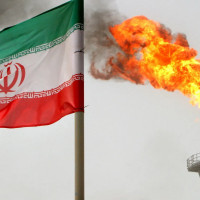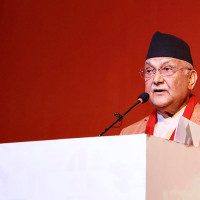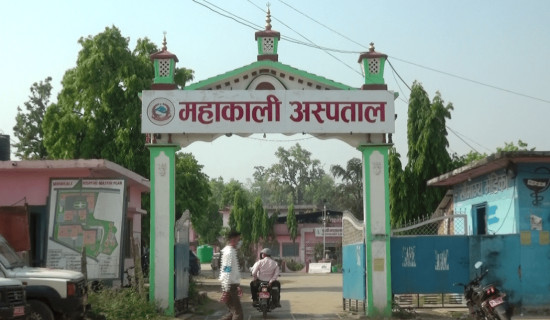- Saturday, 20 April 2024
National exhibition of fine arts brings talented artists together
By Renuka Dhakal,Kathmandu, June 7: With the slogan of 'I, My Country and My Creation,' the national exhibition of Fine Arts has been going on at the Nepal Academy of Fine Arts (NAFA) and the Nepal Art Council since May 29.
The exhibition features 695 artworks contributed by 609 artists. These artworks were selected from 755 submissions by 653 artists.
At the Nepal Art Council, visitors can enjoy a splendid array of folk art and traditional paintings while at NAFA, they can observe modern paintings, Vastu (a traditional architectural concept), various creative arts, handicrafts, and traditional and modern sculptures.
The exhibition encompasses a wide range of artistic expressions, including 269 modern paintings, 136 traditional paintings, 46 modern sculptures, 39 traditional sculptures, 85 handicrafts, 42 folk arts, 47 photographs, 12 replacement artworks, 17 cartoons, 12 emotional artworks, four caricatures, and seven digital artworks.
This year, the Academy has honoured seven artists with the prestigious National Fine Arts Awards for their exceptional achievements in diverse genres of the fine arts. These awardees were selected through a rigorous and highly competitive competition.
Additionally, the Academy also recognised and presented awards to over 25 artists representing various genres, showcasing their remarkable talent and contribution to the world of fine arts.
Raj Prakash Tuladhar has received the prestigious National Fine Arts award for his outstanding skills in Paubha art. His artwork beautifully portrays the revered figure of Guru Padmasambhava, showcasing his exceptional talent and creativity.
Tuladhar shared insights into his artistic process, stating that Padmasambhava Guru was believed to have been born in Oddiyana, a small region located in the early medieval period in Swat district of present-day Pakistan.
According to Tuladhar, Padmasambhava Guru pursued his studies of Buddhism in India before coming to Nepal to engage in the practice of Chakrasaṃvara (tantric Buddhist meditation and deity yoga practice). He meditated in various sacred places such as Halesi and Chobhar.
He also married a girl from the Shakya caste and received education on Chakrasamvara. Eventually, he travelled to Tibet, where he played a significant role in spreading Buddhism. In the Vajrayana tradition, Padmasambhava Guru is regarded as a revered Guru, said Tuladhar.
In his painting, Tuladhar aimed to highlight both Nepali and Tibetan cultures. It took him approximately a year to complete the artwork. Renowned for his expertise in exploring colours and showcasing their unique qualities, Tuladhar employed watercolour techniques to bring his artwork to life. With meticulous brushwork and skillful blending, he masterfully conveyed the significance of Guru Padmasambhava.
Namrata Singh, an artist from Mahottari, has created a captivating folk painting titled 'Who am I.' Using acrylic colours, she skillfully portrays the diverse roles of women in society. The artwork beautifully captures the multitude of responsibilities and contributions that women make in their lives.
Singh's painting showcases women in various roles, such as mothers, caretakers, and supportive figures for their families and loved ones. It also portrays their independence and freedom through the depiction of a woman riding a bicycle. Additionally, it highlights their intellectual capabilities and educational role in society by presenting them as teachers and leaders.
Her skillful use of vibrant colours, incorporating shades of red, green, yellow, blue, white, and orange represents the rich and diverse Mithila culture within the artwork.
'Who am I' by Singh is a powerful depiction of the multifaceted nature of women and the significant roles they play in society. The artwork celebrates their strength, resilience, and divine essence.
Jerom Maharjan, a recipient of the National Fine Arts Award, has created a traditional sculpture that showcases the significance of the Chaitya from the Lichchhavi era. His sculpture depicts Amitabha Buddha in a meditative mudra, seated under the Kirtimukha, also known as the ‘face of glory.’
Kirtimukha is a monstrous face with large fangs and an open mouth. With the blessings of Lord Shiva, the Kirtimukha can often be seen in Hindu temples as well as in Buddhist architecture.
Maharjan, who has been learning the art of stone sculpture for a decade, acquired his skills from his father artist Santalal Maharjan. Graduated from Sirjana College of Fine Arts, the 27-year-old artist is determined to build his career in sculpting.
Gyani Raj Bajracharya, an artist with over 25 years of experience, recently achieved a significant milestone in his artistic career by receiving his first-ever award for his remarkable Thangka artwork titled ‘Aparamita.’
He crafted this Thangka using silver as the base material, adorned with Muga, Turquoise, Lapis, Coral, and Sipi, employing the Filigree technique. At the centre of his masterpiece, one can observe the serene Aparamita Buddha, while Panchamukhi Buddhas are placed on the top, right, and left sides, accompanied by Ashtamangal. Below them, the divine figures of Manjushree and Tara are shown. The artwork is further embellished with delicate gold accents.
The significance of Thangka lies in the belief that those who are unwell or afflicted by illness can find solace and healing by seeking the blessings of the Aparamita Buddha idol, said Bajracharya.
He dedicated seven months of meticulous effort to complete this award-winning art piece, and valuing his masterpiece, he has priced it at Rs. 900,000.
His artistic skills were honed under the guidance of his father, renowned artist Indra Raj Bajracharsya.
Rishita Khatri, who hails from Okhaladhung, has created a mesmerising contemporary sculpture entitled ‘Rhythm of Thoughts.’
This remarkable artwork features five intricately crafted heads, each distinguished by a unique colour. Through her sculpture, Khatri endeavours to explore the diverse spectrum of human emotions, encompassing both the positive and negative aspects.
By skillfully capturing expressions, she vividly portrays how individuals express their emotions whether positive or negative. Artist Uddab Raj Rimal has showcased a captivating contemporary painting titled ‘Dance of Contradiction’ using acrylic colour.
Through his artwork, he wants to portray the contrasting realities of human beings - their inherent truth versus the societal reality they embody.
By employing a variety of body movements, he skillfully portrays the contradictions inherent in these two distinct realms of human existence.
Binaya Rimal’s art titled ‘Aau Milera Aaphno Ghara Singharau’ (Let’s decorate our home together) delves into the prevalent issue of a growing number of individuals opting to leave their home country in pursuit of opportunities abroad.
Through his painting, Rimal sheds light on the phenomenon of today's youth increasingly choosing to migrate abroad, resulting in empty households and communities back home. The exhibition will continue until June 13.

















